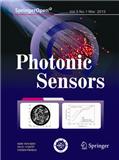| 投稿方式:官网投稿 |
- 栏目频次
- 单位占比
-
热词

低频栏目
-
更多
期刊简介
- 《光子传感器(英文版)》(PhotonicSensors)(季刊),创刊于2011年,是由教育部主管、电子科技大学和德国Springer公司联合出版的英文学术期刊。本刊的宗旨是报道及发表光子传感领域原创性的科学和技术研究的新进展、新成果,涉及领域包括光纤传感器、平面波导传感器、生物光子传感器及相关仪器、传感器复用及组网技术、光子传感器相关材料与器件等。本刊设有研究论文栏目,接收基于新原理、新结构和新材料等光子传感实验研究成果,及实验、理论和仿真相结合的研究报道。还设有研究快报栏目,供广大作者尽快刊登报道上述研究领域重要的最新结果和进展。此外,本刊还开辟了综述专栏发表光子传感热门研究方向的综述及评论文章。所有投稿论文需用英文书写并经过严格的同行评阅。
-
基本信息
- 期刊名称:光子传感器(英文版)(Photonic Sensors)
- 主管单位:教育部
- 主办单位:电子科技大学
- 国内刊号:CN 51-1725/TP
- 国际刊号:ISSN 1674-9251;EISSN2190-7439
-
- 出刊日期:
- 期刊定价:
-
- 邮发代码:
-
- 所在省区:四川
- 邮政编码:
- 联系地址:
-
投稿信息
-
- 学科分类:物理
- 版面费用:待核实
-
- 字数要求:22000-52000
- 查重要求:-
-
- 复合因子:0
- 综合因子:0
-
- 审 稿 费:待核实
- 稿费:待核实
- 本刊可发:
- 特殊属性:第一批认定学术期刊
-
联系方式
- 投稿网址:https://www.editorialmanager.com/phse
- 官网网址:
- 电话传真:028-83200028,61830278(202302期)
-
电子邮箱:photonicsensors@uestc.edu.cn
photonicsensors_edit@uestc.edu.cn(202302期) - 微信公众号:

